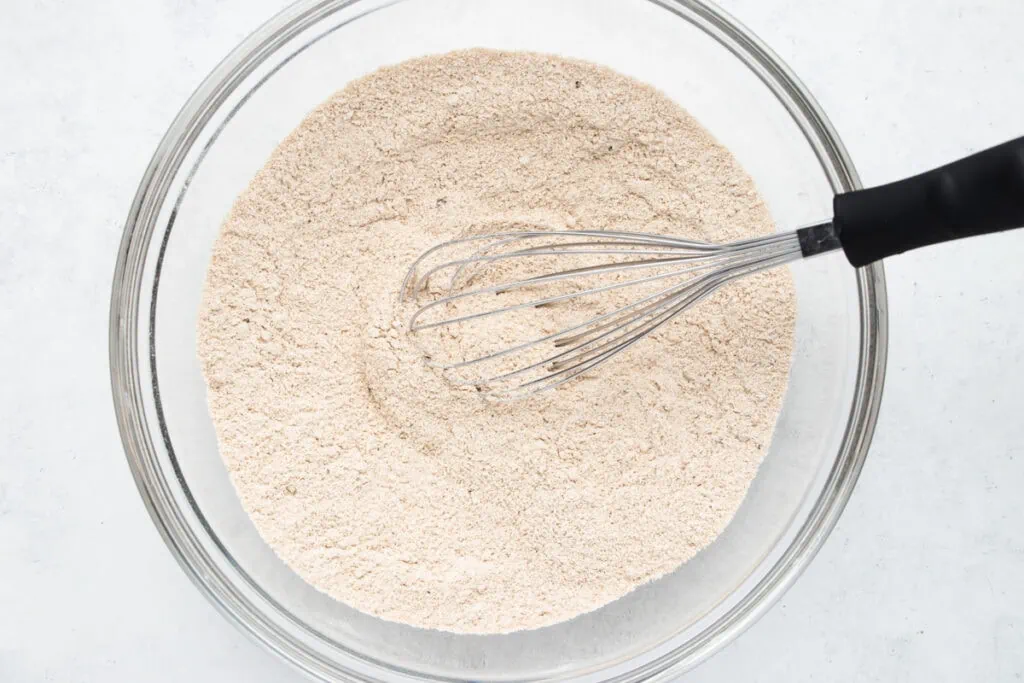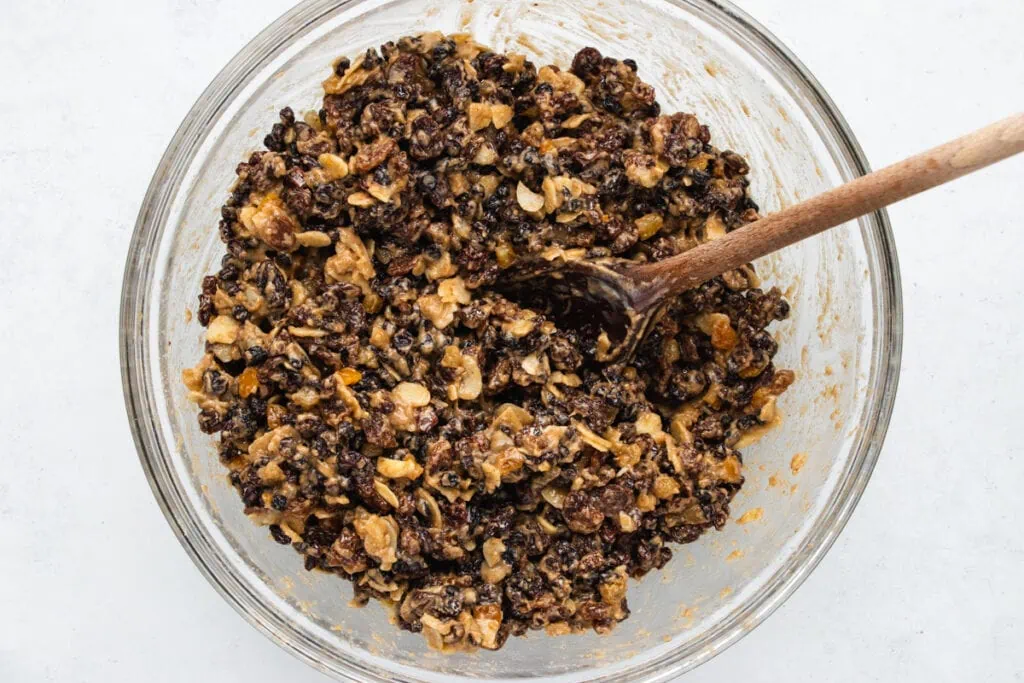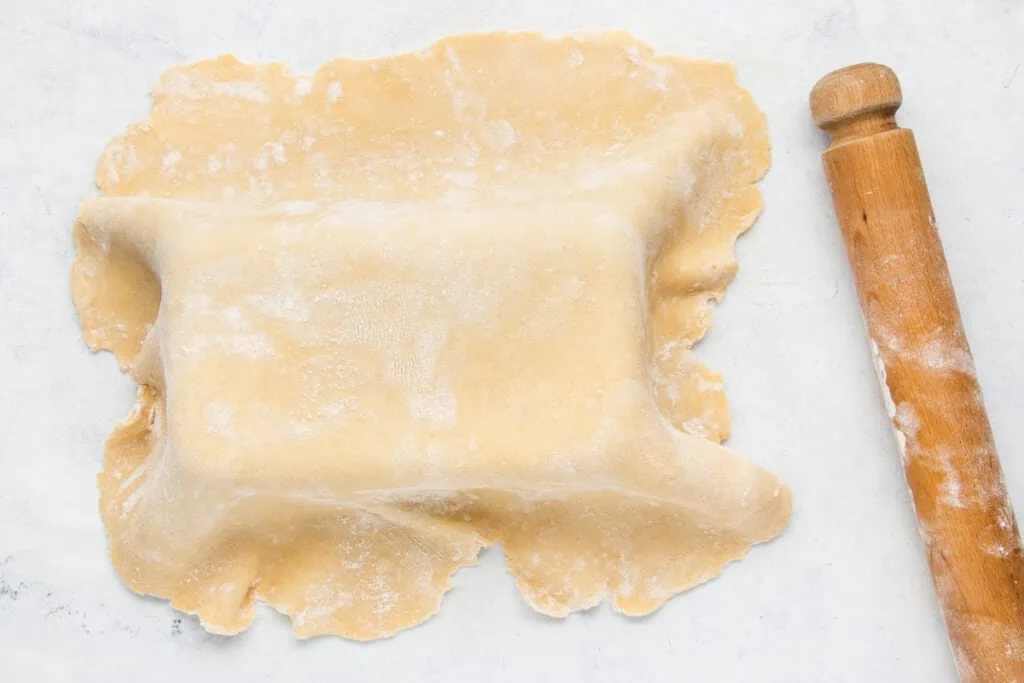Black Bun is probably the Scottish cake you’ve never heard of despite summing up many of the things we love about Scotland. It has a rich history, is steeped in tradition and is still very much relevant today. Plus, it helps that Black Bun is delicious!
What is Black Bun?
Black Bun is a rich fruit cake that contains a variety of dried fruits, including raisins, sultanas, currants, warming spices, and flaked almonds. For some, the cake has a similar taste and texture to a Christmas cake. But it has one huge difference.

You may be wondering why we’ve shared a picture of a pie with you. Unlike your standard Christmas Cake, Black Bun isn’t covered in icing; oh no, it’s actually fully encased in a crumbly, buttery pastry.
Looking more like a savoury pie than a rich fruit cake, Scottish Black Bun was traditionally enjoyed on the twelfth night but is now primarily associated with Hogmanay and the Scottish tradition of First Footing.
Black Bun tastes superb. The cake and pastry combine perfectly and equally well with a wee dram, or some Atholl Brose.
Our recipe brings all the above and more to your kitchen, making it a must-try Scottish recipe. But, unfortunately, Black Bun is one of those foods that only seems to be made at a particular time of year, which is a real shame because this is a cake that will blow your mind!

Black Bun Traditions
Black Bun is a key food to serve at Scottish Hogmanay celebrations and forms part of the first-footing tradition. For those non-Scots, some explanations might be needed at this stage.
We’ll get to our Black Bun recipe soon, we promise! We hope everything is correct for all the lovely Scottish people reading this. Let us know in the comments if we haven’t.


What is Hogmanay?
Hogmanay dates back to the Vikings when they would celebrate the Winter Solstice with wild parties to celebrate the last day of the old year.
Nowadays, Hogmanay is celebrated on the night of the 31st of December, New Year’s Eve, and into the following morning on New Year’s Day. The celebrations can often continue to the 2nd of January, a Scottish bank holiday.
What is First Footing?
So, what is First Footing, and how does Black Bun fit into the celebrations?
First Footing relates to the first person to cross the threshold of your home after midnight on New Year’s Day. So it is often part of a Hogmanay celebration/party in someone’s home.
The first footer must not have already crossed that threshold before midnight, meaning they need to be a brand new visitor to your home. They can also be someone, often a dark-haired male, who left your home before midnight on New Year’s Eve and did not return across the threshold until after midnight.
Gifts are usually given as a token of luck for the coming year, such as money, bread or Black Bun, and coal, or peat said to bring wealth, lack of want, and warmth.
And there you have it. Black Bun has become a traditional food for the holiday season as it’s often made at Hogmanay to be one of the gifts given by the first footer.
If you’re interested in more Scottish traditions have a look at our Burns Night post, there’s a little of the history, the traditions and how to plan the perfect menu.

Why you’ll love this Black Bun recipe
We love traditional Scottish recipes and have taken a lot of inspiration for the recipe and method we are sharing today from older Scottish recipe books and family recipes to ensure it is as authentic as possible.
We use black pepper in our recipe, a great way to add spice, but it seems to be missed out in some of the more modern recipes. It works so well with the other ingredients, so please don’t be afraid of that.
We’ve also stuck with brandy as we noted most older recipes included it, but you can add Scottish whisky instead. The best option is to use brandy and drink whisky as you enjoy your freshly made Black Bun.

It isn’t as complicated to make as you might think and is a tasty delight to enjoy at any time of year. After all, Black Bun’s for life, not just for the Hogmanay celebrations 😉
Things you need to make Black Bun
- Large mixing bowl
- Food processor
- Stand mixer or electric hand mixer
- Baking loaf tin
Ingredients needed to make Black Bun
For the pastry:
- 350g plain flour (2 ¾ cups + 2 tbsp)
- 90g butter (cold, cubed) (1/3 cup + 1 tbsp)
- 90g lard (cold, cubed) (1/3 cup + 1 tbsp)
- ½ tsp baking powder
- Pinch of salt
- 5 tbsp cold water
- 1 beaten egg – for brushing
For the filling:
- 200g plain flour (1 2/3 cups)
- ½ tsp ground ginger
- ½ tsp ground cloves
- 1 tsp cinnamon
- ¼ tsp black pepper
- ½ tsp baking soda
- 100g light brown sugar (1/2 cup)
- 220g raisins (1 cup + 2 tbsp)
- 220g sultanas (1 cup + 2 tbsp)
- 220g currants (1 1/3 cups)
- 100g chopped mixed peel (2/3 cup)
- 80g flaked almonds (1 heaping cup)
- 4 tbsp whole milk
- 1 ½ tbsp brandy

How to make Black Bun – Step-by-step method
To make the Pastry:
We start with the pastry first, as it needs time to chill in the fridge.
Add the flour, baking powder and salt to the bowl of your food processor and mix briefly. Next, add the butter and lard, then pulse until the mixture resembles breadcrumbs. If preferred, you can also rub the fat into the flour by hand in a mixing bowl.
Transfer the mixture to the mixer bowl of an electric stand mixer and add the cold water. Mix with the dough hook attached until you have a soft ball of dough. Again, this can be done by hand if preferred. Simply mix with a fork until it begins to come together, forming a dough, then squash everything into a ball with your hands.



Wrap the dough in cling film and place it in the fridge whilst you make the filling.
To make the filling:
First, whisk together the flour, ginger, cloves, cinnamon, black pepper and baking soda in a large bowl. Next, add the sugar and whisk again to mix.
Add the raisins, sultanas, currants, mixed peel and flaked almonds. Stir together with a wooden spoon. Add the brandy and milk and stir until you have a well-combined, sticky fruit mixture.



Preheat the oven to 180C.
Then roll out the chilled dough on a lightly floured surface. Take a 9×5″ loaf tin and place it upside down. Drape the pastry over the tin to check you have rolled it out enough. It should cover the tin with a generous overhang.

Flip the tin up the correct way and carefully line it with the pastry, pushing it closely into the base and sides, leaving a good few inches of overhand around the edge.

Spoon the filling mixture into your pastry-lined tin, filling the tin to the top. Use a sharp knife to slice off the overhanging pastry and neaten the edges. Roll the leftover pastry into a ball and set aside.
Brush the edges of the Black Bun with the beaten egg.


Roll the leftover pastry into a rectangle that will cover the filling entirely and place it on top of the filled pie, creating the lid or top of your Black Bun. Pinch the edges of the lid and egg-washed sides of the pastry between your fingers to help the two elements stick together firmly.
Take a fork and crimp around the edge before slicing away any excess, again to neaten everything up. Brush the newly affixed lid, now the top of your Black Bun, all over with the beaten egg wash.

Finally, cut a small cross in the centre of the pastry lid and bake for 2 hours.

If the top starts to brown too much during cooking, cover loosely with foil.
Leave in the tin for about 15 minutes before transferring to a wire rack to cool completely.


Variations to try
Decorate your Black Bun.
We have chosen to keep things simple with our Black Bun decoration, but if you do have any pastry offcuts, then feel free to create shapes and place them on top before baking. We have seen a few examples that have added a ribbon on the top or a bow. Make sure you leave enough egg wash for these as well.
Use whisky instead of brandy.
When researching this recipe and trying out variations, we felt it was only right to stick with brandy as this appeared to be the traditional spirit. However, we also think whisky works really well as a substitution or alternative.
Substitutions for dried fruit in Black Bun.
We have used a mixture of dried fruit with our black bun recipe, but if you don’t have exactly what you need, you can make up the quantities with the others. Or why not try some dried berries as an alternative to the traditional black Bun? Dried cranberries and other fruit taste perfectly combine with Black Bun’s spices and other flavours.
FAQs
Does the Black Bun cake work without the pastry?
Yes, it should work as a stand-alone cake, though we’ve never tried it this way. However, we suggest keeping an eye on it in the oven to ensure it doesn’t dry out or overcook.
Can you make Black Bun in advance?
Black Bun can be made up to 3 weeks in advance and stored in an airtight container before slicing and serving.
How do I store Black Bun?
Black Bun is a dense, rich, and flavorful cake, so you may not eat it all in one sitting. A significant positive is that it lasts some time when stored correctly. Some might say that over time, the richness and flavour can develop, much like a good whisky.
Storing Black Bun is simple. You can wrap it in plastic wrap or foil and place it in an airtight container. The same can be done with any leftovers you may have.
However, it stays fresh as long as it’s stored in an airtight container. Keep it at room temperature or even refrigerate it if you wish. It keeps its freshness for at least three weeks from the time of making.
Traditional Scottish Black Bun Recipe

Scottish Black Bun is a traditional recipe that is essentially a fruit cake wrapped in pastry. It's often used as part of the tradition of "first footing" at Hogmanay.
Ingredients
For the pastry
- 350g plain flour (2 ¾ cups + 2 tbsp)
- 90g butter (cold, cubed) (1/3 cup + 1 tbsp)
- 90g lard (cold, cubed) (1/3 cup + 1 tbsp)
- ½ tsp baking powder
- Pinch of salt
- 5 tbsp cold water
- 1 beaten egg – for brushing
For the filling
- 200g plain flour (1 2/3 cups)
- ½ tsp ground ginger
- ½ tsp ground cloves
- 1 tsp cinnamon
- ¼ tsp black pepper
- ½ tsp baking soda
- 100g light brown sugar (1/2 cup)
- 220g raisins (1 cup + 2 tbsp)
- 220g sultanas (1 cup + 2 tbsp)
- 220g currants (1 1/3 cups)
- 100g chopped mixed peel (2/3 cup)
- 80g flaked almonds (1 heaping cup)
- 4 tbsp whole milk
- 1 ½ tbsp brandy
Instructions
- First, make the pastry. Add the flour, baking powder and salt to the bowl of a food processor and mix briefly.
- Add the butter and lard and pulse until the mixture resembles breadcrumbs. You can also rub the fat into the flour by hand in a mixing bowl if preferred.
- Transfer the mixture to the bowl of an electric stand mixer and add the cold water. Mix with the dough hook attached until you have a soft ball of dough. Again, this can be done by hand if preferred. Simply mix with a fork until it starts to come together into a dough, then squash everything into a ball with your hands.
- Wrap the dough in cling film and place in the fridge whilst you make the filling.
- To make the filling, first whisk together the flour, ginger, cloves, cinnamon, black pepper and baking soda in a large mixing bowl.
- Add the sugar and whisk again to mix.
- Add the raisins, sultanas, currants, mixed peel and flaked almonds. Stir together with a wooden spoon.
- Add the brandy and milk and stir until you have a well combined, sticky fruit mixture.
- Preheat the oven to 180C.
- Roll out the chilled dough on a lightly floured surface. Take a 9x5” loaf tin and place it upside down. Drape the pastry over the tin to check you have rolled it out enough. It should cover the tin with a generous overhang.
- Flip the tin up the correct way and carefully line it with the pastry, pushing it closely into the base and sides and leaving a good few inches of overhand around the edge.
- Spoon the filling mixture over the pastry, filling the tin all the way to the top. Use a sharp knife to slice off the overhanging pastry and neaten up the edges. Roll the leftover pastry into a ball and set aside.
- Brush the edges of the pastry with the beaten egg.
- Roll out the leftover pastry into a rectangle and place on top of the filled pastry to cover it completely, squashing it into the egg-washed edges between your fingers to help it stick down.
- Take a fork and crimp around the edge before slicing away any excess once again to neaten everything up. Brush all over the top of the pastry with the beaten egg.
- Cut a small cross in the centre of the pastry lid and bake for 2 hours. If the top starts to brown too much during cooking, cover loosely with foil.
- Leave in the tin for about 15 minutes before transferring to a wire rack to cool completely. This can also be made up to 2 weeks in advance and stored in an airtight container before slicing and serving.
Notes
You can use bought pastry rather than making your own!
Nutrition Information:
Yield:
10Serving Size:
1Amount Per Serving: Calories: 642Total Fat: 22gSaturated Fat: 9gTrans Fat: 0gUnsaturated Fat: 12gCholesterol: 47mgSodium: 219mgCarbohydrates: 105gFiber: 6gSugar: 51gProtein: 11g
The above values are an indication only.

We hope you enjoy making and eating your Black Bun. If you’re making it for Hogmanay or even Christmas, here are a few more recipes you might like to try:
- Steak Pie – Part of a more modern tradition that sees it eaten by a lot of people on New Year’s Day.
- Ecclefechan Tarts – A wonderfully tasty wee tart, perfect for the holiday season.
- Clootie Dumpling – The Scottish version of a Christmas pudding that’s been made since the mid-1700s and this microwave version.
- Cranachan – Possibly the king of Scottish desserts, oats, cream whisky and raspberries; you have to try it.
If the new year is close by when you’re reading this, we hope you have a Happy New Year, and lang may your lum reek!
Phil & Sonja

I am so so excited to finally have a recipe for this. A bit of a story behind this, I remember my Great Aunty Doris calling this Her BlackCake Pie, when we would visit it was always there front ad center other tea trolley amongst servall other fancy morning/afternoon tea delights.
Looks like I had the name wrong. Sadly Aunty Doris passed a long time ago in 1975. Christmas 74/75 was my last afternoon tea.
I will be able to reminisce those amazing times with the Grand Old Dame that was our very special ‘Aunty’ Doris, she wasn’t blood but still family.
I have a question, I seem to remember the top having a layer of Marsipan have you ever known this to be, it might be because Aunty Doris did love sweet things…💚🤩💜
We’re so pleased we can help! We hope this lives up to your memories. We’ve not heard of Black Bun with a Marzipan layer but you could change out to top pastry for a layer if you wanted to!
It’s been a while since I had some black bun ( one been in Canada for nearly sixty years ,
but I remember the taste from my Mums at Hogmanay, great memories.
Thanks , John.
What a lovely thought! Thanks!
Have you ever tried making black bun in mini loaf pans? If so, how long did you bake it?
We haven’t but its a great idea! Anyone else?
I love your website.
I was an apprentice baker early in 1960.
I enjoyed 6 months experience in Goodfellow and Stevens Broughty Ferry, as part of my bakery apprenticeship. In 1960 or so.
I made Black Bun in December for the Hogmanay celebrations.
The filling was prepared by folding the spicey fruit mix into a STRONG BREAD DOUGH.
This was a difficult task to achieve, so much fruit into a small amount of dough.
It was done by hand, on the bench. Taking at least 10 minutes to achieve.
Then it was encased in a pastry skin, as your recipe describes.
Perhaps this can be understood as a traditional method, bread dough being inexpensive and readily available. Can you please share this suggestion with your local sources ?